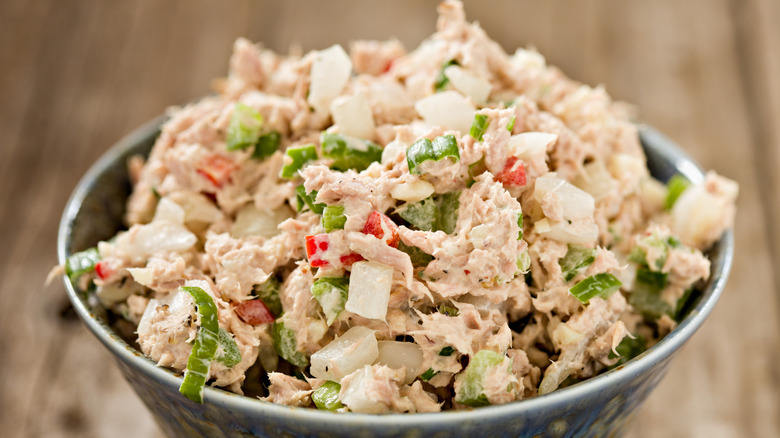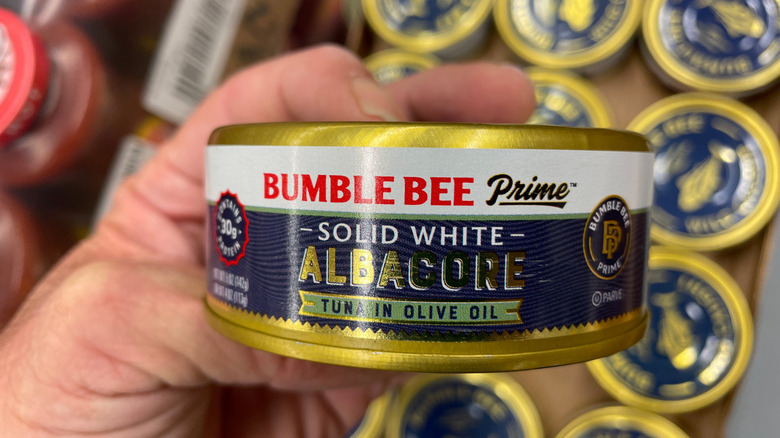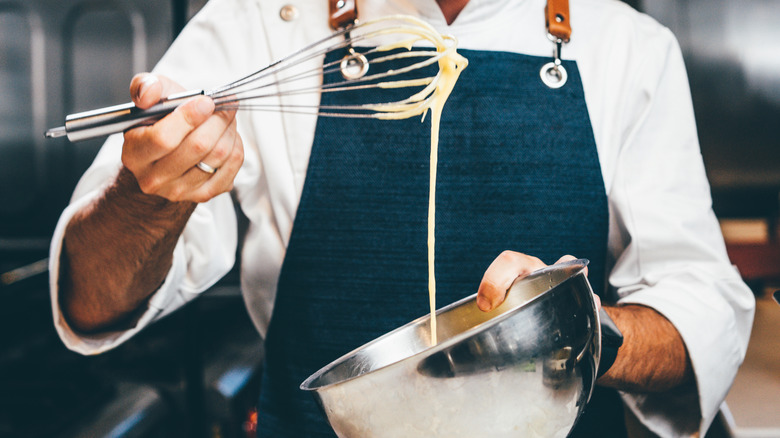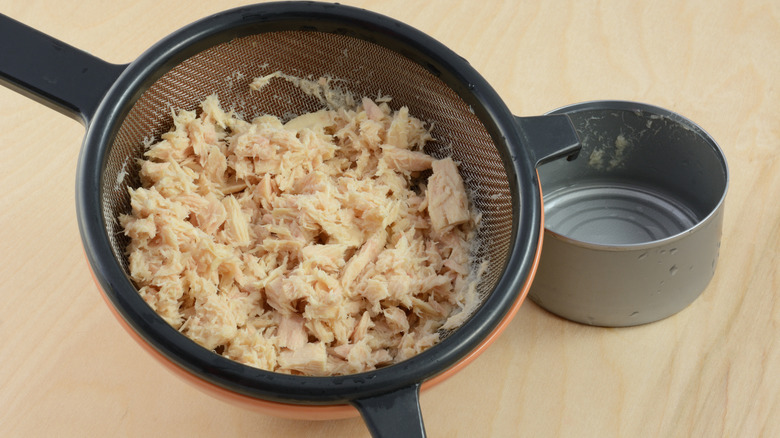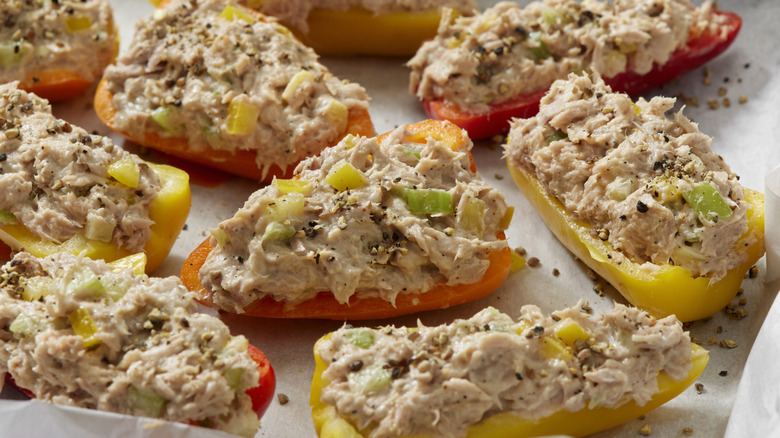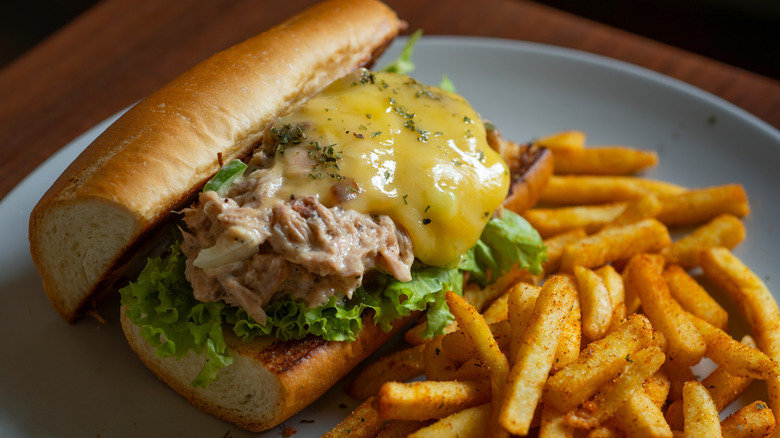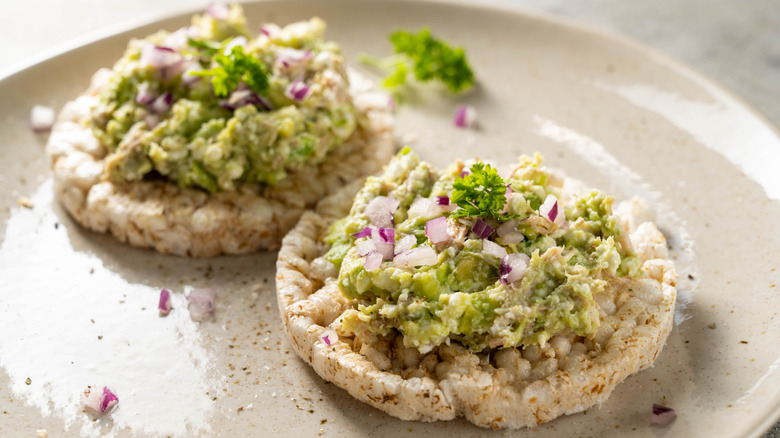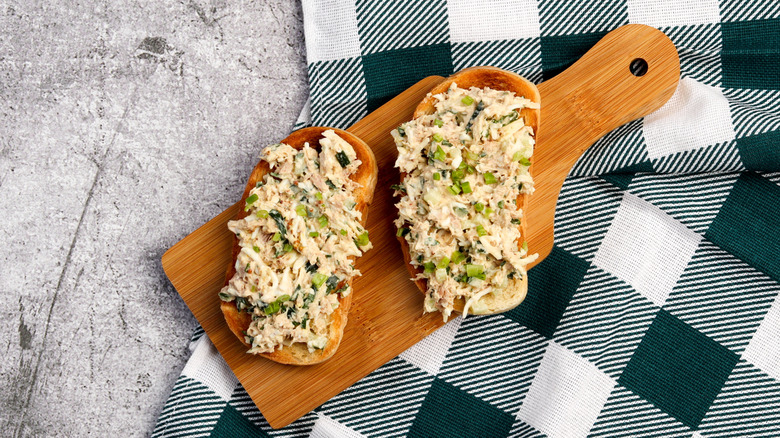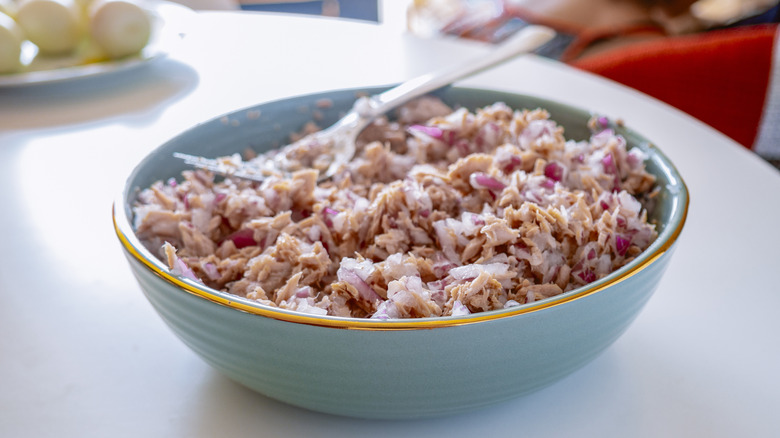5 Experts Explain Why Tuna Salad Always Tastes Better At Restaurants
If you're like many, dining out at a restaurant is an enjoyable experience. Beyond relaxing and chatting with friends or family, the food is (almost) always better than meals made at home. However, it can leave you feeling a bit frustrated. Even when you work hard and practice new recipes at home, the same dish will likely taste better when ordered from your favorite restaurant. If you wonder why sandwiches taste better from a deli – particularly something presumably as simple as tuna salad, you're in the right place.
We've noticed the difference, too, and wanted to get to the bottom of why tuna salad nearly always tastes better when you order it from a restaurant. To help us solve this conundrum, we contacted five restaurant owners and expert chefs. Adam D. Mesnick is the chairman of the board at Deli Board in San Francisco; Laura McCormick is the owner of Urban Deli in Baltimore; Michael Ruggeri is the co-owner of Archie's NY Deli in Boston; Andrew Wengrover is the owner of Sarge's Delicatessen & Diner in New York City; and George Duran is a celebrity chef, comedian, and entertainer. These experts reveal their secrets on making your homemade tuna salad rival any you could order from a restaurant.
Restaurants choose high-quality tuna
Do you know what you look for when you're buying canned tuna? Restaurant owners and professional chefs do, and it can play a bigger part in why their tuna salad tastes better than you might think. Laura McCormick explains, "Quality is number one. We only buy albacore tuna. It's not mixed with soy, so it is a higher quality product." Michael Ruggeri also cites tuna quality as impacting the finished product, explaining that it "will taste better [and] less fishy."
When you go to the grocery store before making tuna salad, pay close attention to the different types. In addition to the solid white albacore that both McCormick and Ruggeri recommend, you'll likely find chunk light tuna. While you can use cheaper chunk light tuna for tuna salad, it doesn't offer as fresh a taste as solid albacore tuna. As Ruggeri alluded, non-albacore tuna can have a fishier flavor. This is because chunk light tuna is often made using different types of tuna, which can impart this stronger, fishier taste. Bottom line: Prioritize quality over price if you want your tuna salad to taste incredible.
Experts know which mayo to use
Mayonnaise is an integral part of tuna salad. So, it's no surprise that professional chefs have also mastered the art of mixing it with tuna to create something with the optimal flavor and texture. According to Adam Mesnick, "Not all mayonnaise is created equally. The mayo must stay creamy and not water itself down." Here's another reason not to skimp when buying ingredients for your tuna salad. Stick with well-known and trusted mayo brands instead of lesser-known options that might not offer the same quality and consistency.
Michael Ruggeri shares another mayonnaise-related tip: He recommends using extra-heavy mayo. "I don't think many people use it at home, but restaurants do, and for a good reason. It's delicious," he says. Now also isn't the time to watch your calories and choose a light mayonnaise, at least not if you want a restaurant-worthy tuna salad. With a heavier mayo, Ruggeri points out that "you don't need to use as much, so you can still taste the tuna."
The tuna is fully drained
Who wants a watery tuna salad or tuna melt? Restaurant chefs know that the answer to this question is "nobody." Michael Ruggeri says, "Probably the most important part is the preparation. Squeezing the tuna as dry as possible so it can take on the flavor of the dressing is probably the biggest reason why restaurant tuna tastes better." He explains that this will ensure that the dressing or mayonnaise flavor is what you taste, complementing the tuna — not that water from the can.
If you want to make tuna salad at home, it is essential to know how to drain all the liquid. One option is to use the can's lid. After using your can opener, press the lid down over the contents as you carefully turn the can over to let the excess liquid drain. The more firmly you press, the more liquid you'll be able to remove. Alternatively, you can use a colander or strainer. If you opt for this method, you must press firmly against the tuna while draining it. Otherwise, some liquid will be left behind.
Professional chefs are experts at seasoning
Proper seasoning is another reason why restaurant tuna salad is often superior to what home chefs prepare. After all, as Adam Mesnick explains, "Tuna needs seasoning — it's coming from a can." Without any seasoning, your tuna salad will be overly bland or may have a stronger fishy flavor than you would like. In fact, Mesnick explains that he "seasons with seasoning and salt pretty liberally."
Beyond salt and pepper, other ingredients can also serve as seasonings and flavor enhancers for your tuna salad. Laura McCormick recommends using celery and shares a few tips that she thinks will help you upgrade tuna salad when preparing it at home. "When I add celery, I clean it and pull the strings off. I also put a little celery leaf, which has most of the flavor of the celery. Most people discard that, which is a mistake," she says.
Learn which toppings can upgrade tuna salad
While there is nothing wrong with a basic tuna salad or tuna salad sandwich, professional chefs know exactly which toppings to add to take it to the next level. Adam Mesnick recommends melting cheese over a tuna salad sandwich. He explains, "The classic tuna melt [with] American cheese and tuna works well." If you always stick to plain and cold tuna salad when preparing it at home, maybe it is time to switch things up and give your hand a try at making a tuna melt.
You could even further upgrade the classic tuna melt with some additional ingredients. Mesnick says, "Add bacon, and it is even more delicious." Other topping options to consider are pickles, apple slices, avocado, or crunchy potato chips. You could also play around with different types of cheese to find a new and exciting flavor combination that you didn't know you were missing out on.
Know when flavorings get too complicated
While professional chefs know what to add to upgrade the taste of their tuna salad, they also know when to stop and not overcomplicate things. Laura McCormick says, "Keep it simple, stupid. Make sure there's not too many flavors that you're trying to combine." Don't try getting to over-adventurous and adding too many different ingredients that won't end up complimenting each other. For example, tuna salad with cranberries can taste great. Relish can jazz up tuna salad. However, tuna salad with cranberries and relish will almost certainly be a bridge too far and will result in some sad taste buds.
McCormick also explains the importance of giving your tuna salad mixture a taste test before serving it. She says, "At our restaurant, we might make several batches a day. And, when one of the quality control people walks by, they ask for a taste." If something isn't right, professional chefs will make changes. It is important for you to do the same at home when you're the chef (and your family might enjoy the honor of being "quality control!").
Professional chefs make the bread taste good too
When you order a tuna salad sandwich or a tuna melt from a restaurant, if you pay attention, you'll notice that the bread also tastes incredible. Chef George Duran explains, "It's all about the bread. It's toasted to perfection with butter [which is] something most home cooks don't think about doing." Duran highlights that toasting bread with butter on a griddle or nonstick pan will deliver "caramelization from the toasted buttery crispness to bring out the savoriness of the tuna and cheese, balancing the sandwich perfectly."
Duran recommends opting for an open-faced tuna salad sandwich or tuna melt that you can eat with a knife and fork. He warns that a sandwich is more likely to fall apart or drip tuna as you eat, which can be messy and prevent you from getting the right ratio of tuna salad to bread. But, he explains, an open-faced sandwich allows you to enjoy the buttery and toasty flavor of the bread with each bite of the tuna salad.
Chill the tuna salad before serving it
If you think carefully about the difference between your homemade tuna salad and that which you order from a restaurant, you should be able to identify another key distinction. Hint: It relates to the temperature of the tuna salad. Andrew Wengrover states, "Tuna is also better when it's cold. When you first make tuna at home, it's warm out of the can, so it's just ok." Compare this to when you order it from a restaurant. The tuna salad is nice and cool, making it much more refreshing.
Fortunately, remedying this problem is pretty simple. You just have to plan ahead and leave time for your tuna salad to chill before serving it. At a minimum, you'll want to leave it in the refrigerator for an hour or two. However, if you can, chilling it overnight is ideal. As the ingredients sit together for several hours, the flavors will meld for a more enjoyable meal.
Anything tastes better when you don't make it for yourself
Have you noticed that tuna salad isn't the only thing that tastes better at a restaurant? You may find that everything from spaghetti to pancakes tastes better at a restaurant. While it is easy to assume that the chefs are better at cooking than you are, don't be so hard on yourself. As Laura McCormick says, "Everything tastes better when you don't make it yourself." There certainly is something to be said about not having to cook for yourself.
Beyond that, George Duran explains that how you think about things can also play a role in how something tastes. "It's the psychology of thinking you are getting a better tuna salad because you're paying a premium for it at the restaurant." You want to feel satisfied with what you're spending your money on and need to convince yourself that the expense of going out to dine is better than making a comparable sandwich at home (often for a fraction of the cost).
